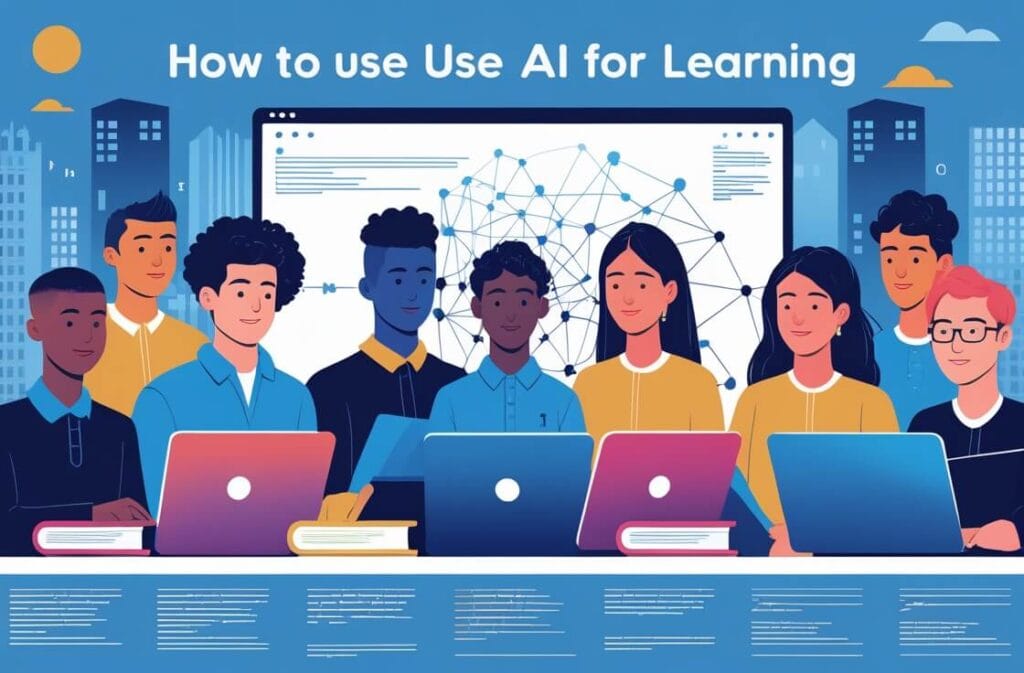
I’ll never forget the moment I realized AI for learning had completely changed my approach to education. It was 2 AM, and I was struggling with a complex physics concept that just wasn’t clicking. My textbook explanations felt robotic, and YouTube videos weren’t addressing my specific confusion. Then I tried asking an AI assistant to explain it using a cooking analogy – something that related to my hobby. Within minutes, the concept finally made sense!
Here’s the thing: 73% of students who use AI for learning report improved academic performance, according to recent educational technology studies. But most people are barely scratching the surface of what’s possible. They’re using AI for learning like it’s just a fancy search engine, when it’s actually more like having a patient tutor, study buddy, and research assistant all rolled into one.
The landscape of AI learning has exploded in 2025 and heading into 2026. We’re not just talking about chatbots anymore – we’re talking about personalized learning paths, adaptive study systems, and tools that actually understand how YOU learn best. And honestly? It’s kind of overwhelming if you don’t know where to start.
That’s exactly why I put together this guide. I’ve spent the last few years experimenting with AI learning across different subjects, making plenty of mistakes along the way (like that time I trusted AI-generated practice problems without verifying them – yikes!), and figuring out what actually works. Whether you’re a student trying to ace your exams, a professional upskilling for your career, or just someone who loves learning new things, this guide will show you how to harness AI for learning in ways that actually stick.
AI for Learning: What It Really Means
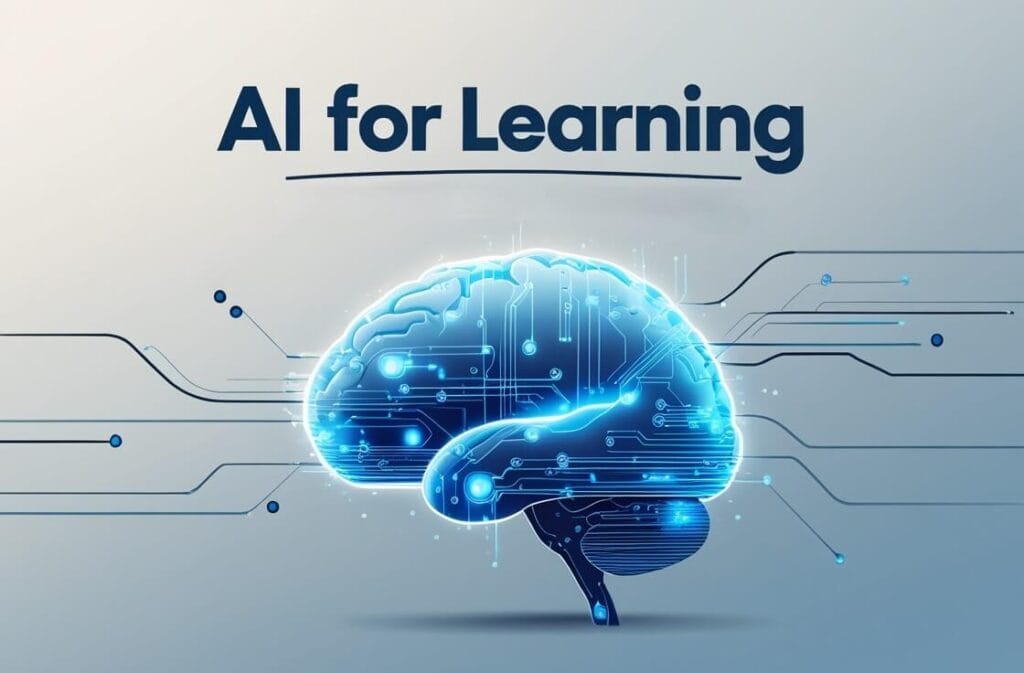
When I first heard about AI for learning, I thought it was just about asking questions to a chatbot. Boy, was I wrong! AI for learning is so much more sophisticated than that, and understanding what it really encompasses changed everything about how I approach education.
AI for learning refers to the use of artificial intelligence technologies to enhance, personalize, and optimize the learning experience. It’s not just one tool or one approach – it’s an entire ecosystem of intelligent systems designed to adapt to your unique learning style, pace, and goals. Think of it as having technology that doesn’t just give you information, but actually helps you understand and retain it better.
The core of AI for learning lies in machine learning algorithms that analyze how you interact with educational content. These systems track which concepts you grasp quickly, which ones you struggle with, and even the times of day when you’re most focused. Over time, AI for learning platforms build a profile of your learning patterns and adjust accordingly. It’s like having a teacher who’s been studying YOU instead of just teaching from a fixed curriculum.
What really blew my mind was discovering that AI for learning can identify gaps in my knowledge that I didn’t even realize existed. I was studying web development once, confidently moving through tutorials, when an AI learning platform flagged that I had a shaky understanding of a fundamental concept I’d learned months earlier. Turns out, that weak foundation was about to cause problems in the advanced material I was tackling. The AI learning system caught it before I wasted hours being confused!
Here’s what modern AI for learning actually includes:
- Adaptive learning systems that adjust difficulty based on your performance
- Intelligent tutoring systems that provide personalized explanations and feedback
- Natural language processing tools that can answer questions in conversational ways
- Content generation systems that create custom practice problems and study materials
- Progress tracking algorithms that identify your strengths and weaknesses
- Predictive analytics that forecast which concepts you might struggle with next
The difference between traditional online learning and AI for learning is huge. Traditional e-learning gives everyone the same videos, the same quizzes, the same path. AI learning creates a unique educational journey for each person. When I was struggling with statistics, the AI noticed I learned better with real-world examples rather than abstract formulas, so it started presenting concepts using data from sports and social media – topics I actually cared about!
But here’s something important I learned the hard way: AI for learning is a tool, not a replacement for actual thinking and effort. I made the mistake early on of just passively accepting everything the AI told me without questioning or deeply engaging with it. That’s when my retention was terrible. AI for learning works best when you use it actively – asking follow-up questions, requesting different explanations, and challenging yourself to explain concepts back to the AI in your own words.
The technology behind AI learning has gotten incredibly sophisticated. We’re talking about neural networks that can understand context, remember your entire learning history, and even detect when you’re getting frustrated based on your interaction patterns. Some advanced AI for learning platforms can tell when you’re just clicking through content without actually reading it. They’re smart like that!
What excites me most about AI for learning in 2026 is how accessible it’s become. You don’t need to be at a fancy university or work for a big tech company to access powerful AI learning tools. Many of the best AI learning platforms are free or incredibly affordable, democratizing education in ways we’ve never seen before.
Choosing the Right AI Learning Tools for Your Needs
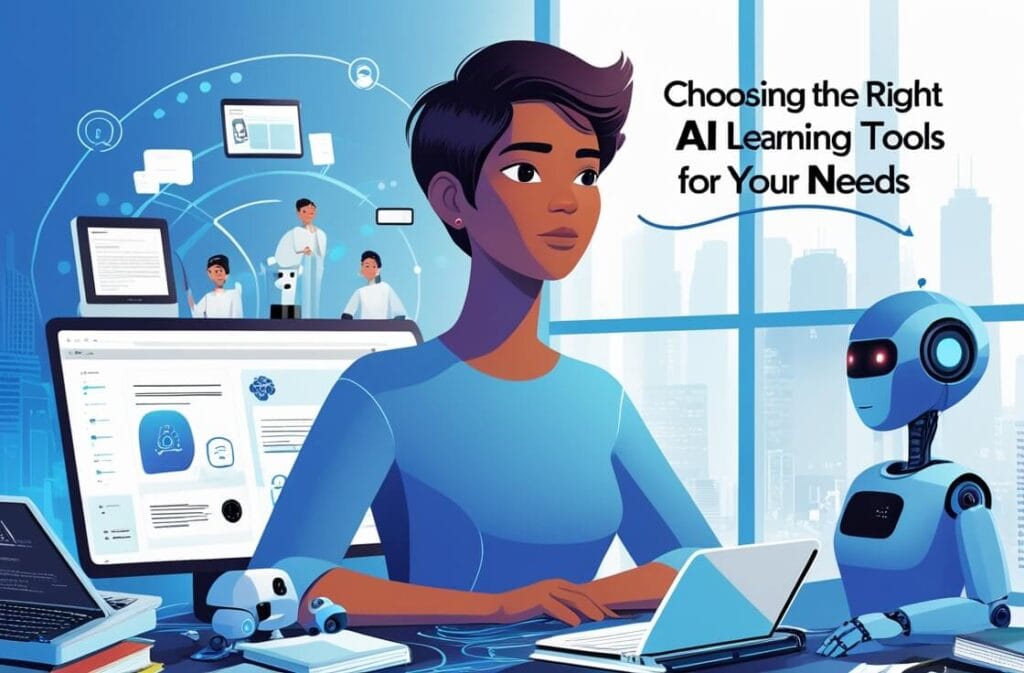
Okay, so this is where I made my biggest mistakes when I started using AI for learning. I got excited and signed up for like seven different platforms at once, thinking more tools would equal better learning. Spoiler alert: it didn’t! I ended up overwhelmed, barely using any of them effectively, and definitely not getting my money’s worth from the paid subscriptions.
Choosing the right AI for learning tools is less about collecting as many as possible and more about finding the ones that actually match your learning goals and style. After wasting probably three months bouncing between platforms, I finally figured out a system that works.
First, you need to identify what you’re actually trying to learn. AI learning tools are becoming increasingly specialized. Some excel at language learning, others are brilliant for coding, and some are better for academic subjects like math or science. I learned this when I tried using a general-purpose AI chatbot to learn Spanish – it was okay, but nowhere near as effective as AI for learning platforms specifically designed for language acquisition with pronunciation feedback and conversation practice.
The major categories of AI for learning tools you’ll encounter include conversational AI assistants (like ChatGPT, Claude, and others), specialized learning platforms with built-in AI (like Khan Academy’s AI tutor or Duolingo’s AI features), AI-powered note-taking and study apps, and adaptive learning management systems used by schools and universities. Each serves different purposes in the AI learning ecosystem.
Here’s my practical framework for choosing AI for learning tools:
- Define your learning objective clearly – Are you studying for an exam, learning a new skill for work, or exploring a hobby?
- Assess your current knowledge level – Beginner-friendly AI for learning tools are different from advanced ones
- Consider your learning style – Do you learn better through conversation, visual content, practice problems, or reading?
- Check for subject-specific features – Language learning AI needs different capabilities than coding or math AI
- Evaluate the feedback mechanisms – Good AI for learning tools provide detailed, actionable feedback, not just right/wrong answers
- Look at integration options – Can the AI learning tool work with your existing study system?
- Test the free version first – Most quality AI for learning platforms offer free tiers or trials
I currently use three main AI for learning tools regularly, and each serves a distinct purpose. For general questions and concept explanations, I use conversational AI assistants because they’re incredible at breaking down complex topics into understandable chunks. For structured learning with progress tracking, I use subject-specific AI learning platforms that provide guided curricula. And for active recall and spaced repetition, I use AI-powered flashcard systems that optimize review timing.
One thing that really improved my results with AI for learning was understanding that different tools have different strengths at different stages of learning. When I’m first exploring a new topic, I use conversational AI for learning tools to ask broad questions and get oriented. Once I understand the basics, I switch to more structured AI learning platforms that provide systematic practice and skill-building. Finally, when I’m reviewing and reinforcing, I rely on AI-powered spaced repetition systems.
The mistakes I see people make with AI for learning tools are pretty consistent. They either stick with just one tool for everything, missing out on specialized features, or they overcomplicate their setup with too many tools that overlap. They also often ignore the importance of data privacy – some AI learning platforms are better than others at protecting your information, and it’s worth checking those policies before uploading all your study materials.
Cost is another consideration with AI learning tools. While many offer free tiers, the premium features can add up quickly if you’re not careful. I made the mistake of subscribing to multiple paid AI for learning services simultaneously when I could’ve gotten 80% of the benefit from free versions and one strategic paid subscription. Now I’m much more intentional about where I invest financially.
Here’s something that really helped me: keeping a simple learning journal where I track which AI for learning tools I’m using for what purpose. It sounds basic, but it prevented me from mindlessly opening apps and instead helped me use each tool strategically. When I’m studying economics, I know exactly which AI for learning platform gives me the best practice problems. When I’m learning a programming language, I know which AI assistant provides the clearest code explanations with good examples.
The AI learning landscape changes rapidly too. New tools emerge constantly, and existing ones add new features all the time. I’ve learned to stay informed through educational technology communities and occasionally reassess my toolkit every few months. What was the best AI for learning solution six months ago might not be today.
Setting Up Your AI Learning Environment

Getting your AI for learning environment set up properly was something I completely underestimated at first. I just jumped in without any structure, and it showed in my results. My study sessions were scattered, I couldn’t find previous conversations with AI assistants when I needed to reference them, and I had no good system for tracking what I’d actually learned versus what I’d just skimmed.
Creating an effective AI for learning environment is about more than just having the right tools – it’s about organizing your digital workspace so that AI learning actually enhances your study process instead of adding chaos to it. After lots of trial and error, I’ve developed a setup that makes my AI for learning sessions productive and my progress visible.
The foundation of a good AI learning environment starts with organization. I created a dedicated folder structure on my computer specifically for AI-assisted learning. Inside, I have separate folders for different subjects or skills I’m learning, and within each, I keep subfolders for AI-generated study materials, conversation logs with AI assistants, practice problems, and notes. This might sound overly structured, but trust me – when you’re three months into using AI for learning and need to reference an explanation you got weeks ago, you’ll be grateful for the organization.
One game-changer for my AI for learning setup was implementing a consistent naming convention. Every time I export a conversation with an AI learning tool or save AI-generated content, I use the same format: date, topic, and type of material. For example: “2026-01-15_Statistics_Concept-Explanation” or “2026-01-20_Python_Practice-Problems“. It seems minor, but searchability becomes crucial when you’re accumulating lots of AI learning resources.
Your physical environment matters too, even though we’re talking about AI for learning. I learned this when I noticed my AI study sessions were way less effective when I was working from my couch versus sitting at my desk. There’s something about having a dedicated learning space that puts your brain in the right mode. When I sit down at my desk and open my AI for learning tools, my brain knows it’s time to focus. Plus, having a good setup means you can easily reference multiple sources – maybe an AI for learning platform on one screen and your notes on another.
Here are the essential components of an effective AI for learning environment:
- Dedicated browser or app workspace for learning tools separate from entertainment and social media
- Organized file system for storing AI-generated materials and learning resources
- Consistent routine for when and where you engage with AI for learning
- Note-taking system that integrates with your AI learning sessions
- Backup solution for important AI-generated study materials
- Minimal distractions in your physical and digital space
- Comfortable setup that supports longer study sessions without physical strain
Something I wish I’d done earlier was setting up a personal knowledge management system that works seamlessly with AI for learning. I started using a note-taking app that lets me link concepts together, and whenever I learn something through AI learning tools, I immediately add it to my knowledge base with links to related concepts. This creates a web of understanding rather than isolated facts. The AI for learning tools provide the information, but my knowledge management system helps me actually integrate and remember it.
The technical aspects of your AI for learning environment matter too. Make sure you have reliable internet connectivity – nothing kills momentum like your AI learning session getting interrupted by connectivity issues. I also learned to keep my devices charged or plugged in because there’s nothing worse than losing an insightful AI-generated explanation because your laptop died before you could save it.
Privacy and security should be part of your AI for learning environment setup as well. I create separate accounts for my educational AI tools, use strong passwords, and I’m careful about what personal information I share in my learning sessions. Some AI for learning platforms retain conversation history, which is useful for tracking progress, but you want to make sure you’re comfortable with their data policies.
One aspect of AI for learning environments that people often overlook is managing notifications and interruptions. I configured my AI for learning tools to minimize distracting notifications. When I’m in a focused study session using AI for learning, I don’t need popup reminders about features I’m not using or suggestions to try new tools. I turned most of that stuff off, and my concentration improved dramatically.
The social dimension of your AI for learning environment is worth considering too. While AI for learning can feel like a solitary activity, I found value in connecting with others who are also using AI for learning. I joined a few online communities where people share tips, discuss challenges, and exchange strategies for AI-assisted education. Sometimes someone shares an AI for learning technique I never would’ve thought of, and it completely changes my approach.
Time management is another critical piece of the AI for learning environment puzzle. I blocked out specific times in my calendar for AI-assisted study sessions, treating them as seriously as I would a class or meeting. Without this structure, I found myself either spending too much time with AI for learning tools (going down rabbit holes of interesting but not immediately relevant information) or not engaging consistently enough to see real progress.
Creating Effective Prompts for AI Learning
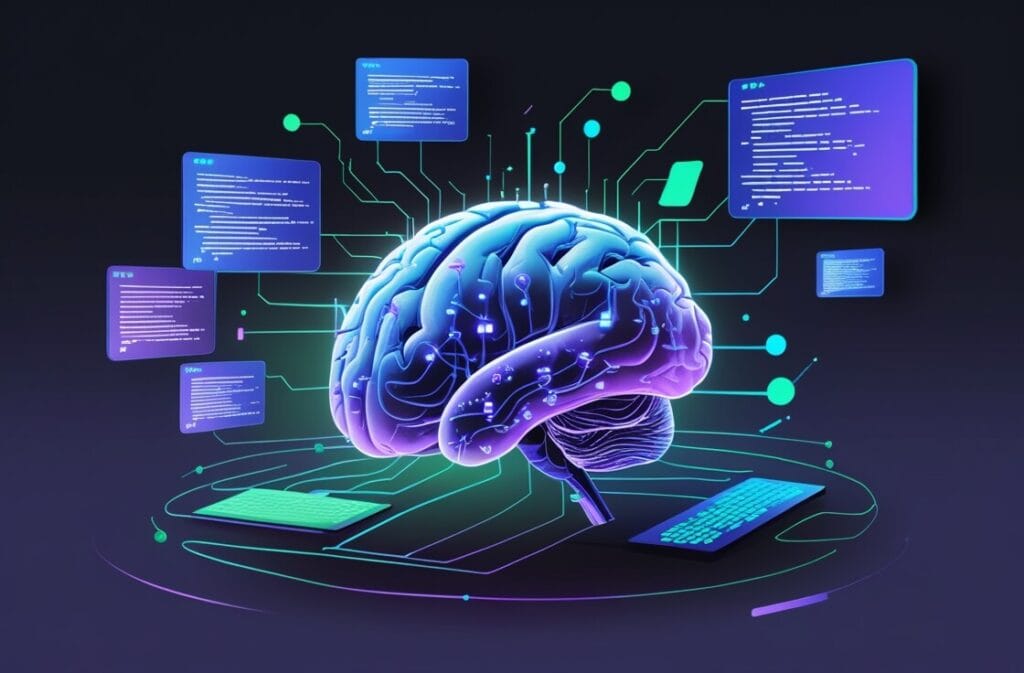
This is where the magic really happens with AI for learning, and it’s also where I struggled the most initially. I’d ask vague questions and get vague answers, then wonder why AI for learning wasn’t living up to the hype. Turns out, the quality of what you get from AI for learning is directly proportional to the quality of your prompts. Garbage in, garbage out – that old saying applies perfectly here!
The art of prompt engineering for AI for learning is something that dramatically improved my results once I started taking it seriously. I went from asking things like “explain calculus” to crafting specific, context-rich prompts that generated incredibly helpful responses. The difference in usefulness was night and day.
Effective prompts for AI learning need several key components. First, they need context. Instead of just asking “What is photosynthesis?” I learned to ask “I’m a biology student struggling to understand photosynthesis. I understand that plants need sunlight, but I’m confused about what’s actually happening at the chemical level. Can you explain the light-dependent reactions in simple terms?” See the difference? The AI for learning tool now knows my level, my specific confusion point, and how I want the information presented.
Specificity is your best friend when creating prompts for AI learning. The more precise you are about what you want to learn and how you want to learn it, the better the AI can help you. I made a habit of including details like my current understanding level, what I’ve already tried to learn, where I’m getting stuck, and what format would be most helpful (examples, analogies, step-by-step breakdown, etc.).
Here’s a framework I developed for creating powerful AI for learning prompts:
- State your current knowledge level – “I’m a beginner” or “I’ve studied this before but need a refresher”
- Define your learning goal – What specifically do you want to understand or be able to do?
- Explain your confusion or knowledge gap – Where exactly are you stuck?
- Request a specific format – Examples, analogies, step-by-step guides, practice problems, etc.
- Ask for checking your understanding – Request that the AI quiz you or ask you to explain concepts back
- Specify the depth you need – Overview vs. detailed explanation vs. expert-level analysis
One technique that transformed my AI for learning experience was the “explain it to me like” approach. When I was learning about blockchain technology, I asked the AI for learning tool to “explain it to me like I’m someone who understands how email works but has never heard of cryptocurrency.” The explanation I got was perfect because it built on knowledge I already had. I’ve used this with all kinds of topics – “explain quantum mechanics like I’m someone who’s watched science fiction movies” or “explain machine learning like I’m a baker who understands recipes.”
Follow-up prompts are where AI for learning really shines, and this is something I didn’t utilize enough at first. I’d get an explanation, say “okay, cool,” and move on. Now I always ask follow-up questions. If the AI explains a concept, I ask it to quiz me on it. If it provides an example, I ask for a different example or ask “what would happen if we changed this variable?” This interactive approach to AI for learning makes the knowledge stick so much better.
The biggest mistake I see people make with AI learning prompts is being too passive. They accept the first explanation without pushing deeper, without asking “but why?” or “can you show me an example of this?” Active engagement through thoughtful prompts is what separates people who get amazing results from AI for learning versus those who find it just okay.
I also learned to use AI learning to create custom practice materials. Instead of just asking for explanations, I’d say “Create 10 practice problems about [topic] at an intermediate difficulty level, and then provide detailed solutions after I attempt them.” This transforms AI for learning from a passive information source into an active study partner. I’ve generated hundreds of practice problems this way across different subjects.
Another powerful prompt strategy for AI learning is asking the AI to identify your misconceptions. I’ll explain my understanding of a concept in my own words, then ask “What am I getting wrong or missing in my understanding?” This meta-cognitive approach to AI for learning helps catch errors before they become ingrained. I discovered I had fundamental misunderstandings about certain programming concepts that I’d been carrying around for months until I used this prompt technique.
When using AI for learning to prepare for exams or assessments, I create prompts that simulate test conditions. “Ask me 5 random questions about [topic] that would be appropriate for a [level] exam, and don’t give me the answers until I’ve responded to all of them.” This turns AI for learning into a study partner who helps you practice recall, not just recognition.
Refinement is key with AI for learning prompts. If you don’t get a useful response, don’t just give up – refine your prompt. I’ll often say “That explanation was too technical for my current level, can you simplify it?” or “That makes sense, but can you provide a concrete example?” Treating AI for learning as a conversation rather than a one-shot question-and-answer session makes all the difference.
One advanced technique I’ve started using with AI for learning is creating “teaching prompts” where I ask the AI to let ME explain a concept and then provide feedback. “I’m going to explain [concept] in my own words. Please listen and then tell me what I got right, what I got wrong, and what important points I missed.” This Feynman Technique approach using AI for learning is incredibly effective for retention.
Personalizing Your AI Learning Experience
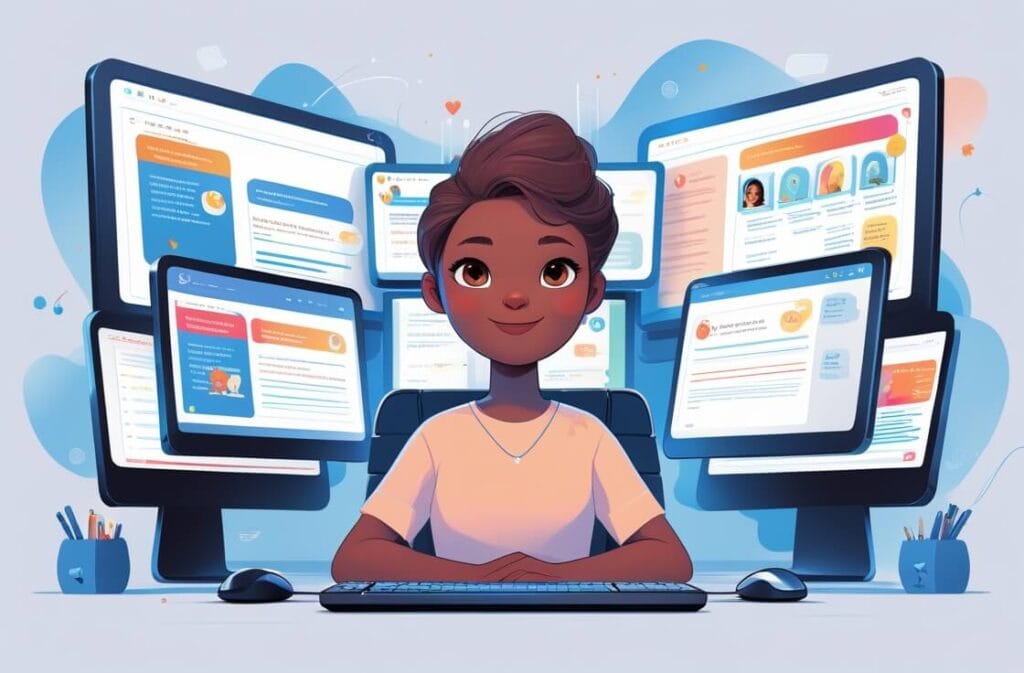
Here’s something that completely changed my relationship with AI for learning: realizing that personalization wasn’t just a nice feature – it was essential for actually making progress. For months, I was using AI for learning tools the same way everyone else was, following generic advice and getting generic results. Then I started experimenting with customization, and everything clicked into place.
Personalizing your AI for learning experience means training the AI to understand your unique learning style, preferences, background knowledge, and goals. It’s about moving beyond one-size-fits-all education and creating an approach that actually works for your brain. And honestly? This is where AI learning becomes truly revolutionary compared to traditional education methods.
The first step in personalizing AI learning is understanding your own learning style. I spent some time reflecting on when I learn best – turns out I’m a visual learner who needs concrete examples before abstract concepts make sense. Once I knew this, I started explicitly telling AI for learning tools “I’m a visual learner, can you use diagrams or visual metaphors to explain this?” The quality of explanations I received immediately improved because they were tailored to how MY brain processes information.
Your learning history is valuable data for personalizing AI for learning. I started keeping a learning journal where I track not just what I’m studying but how different approaches work for me. Do I retain information better after watching videos, reading text, or practicing problems? Do I focus better in morning or evening study sessions? Does spaced repetition work better for me than intense cramming? These insights inform how I interact with AI for learning tools.
One personalization strategy that really works with AI learning is creating a “learner profile” that you share with your AI tools at the start of new topics. Mine includes my educational background, areas of strength and weakness, learning preferences, time constraints, and goals. When I start learning something new with AI for learning, I provide this context upfront, and the AI can immediately tailor its approach. It’s like giving a tutor your full background before they start teaching you.
Here’s what I include in my personalized AI for learning profile:
- Educational background and experience level in relevant areas
- Learning style preferences (visual, auditory, kinesthetic, reading/writing)
- Time availability and scheduling constraints
- Short-term and long-term learning goals
- Previous challenges with similar subjects
- Preferred learning pace (intensive vs. gradual)
- Career or personal context for why I’m learning this topic
- Preferred types of examples and analogies that resonate with me
The pace of learning is highly personal, and AI for learning tools can adapt to yours if you tell them. I’m someone who likes to go deep on topics rather than skim broadly, so I explicitly tell AI learning systems “I want to fully understand this concept before moving on, even if it takes longer.” Other people prefer rapid progress with surface-level understanding first, then deepening later. Neither approach is wrong – they’re just different, and AI for learning can accommodate both.
Cultural context matters in personalized AI for learning too. I’ve found that asking for examples from my own cultural background or experiences makes concepts more relatable and memorable. When learning about economic principles, getting examples involving businesses or scenarios from my own country rather than generic international examples helps it stick better. AI for learning tools can provide this localization if you request it.
One aspect of personalization I discovered through AI learning is identifying and working around my cognitive patterns. I noticed I get mentally fatigued after about 45 minutes of intensive learning, so I started asking AI learning tools to structure sessions in 40-minute chunks with clear breakpoints. I’ll literally say “I want to learn about this topic, but structure it in modules that take about 40 minutes each.” This self-awareness combined with AI for learning flexibility keeps me from burning out.
Personalizing your AI for learning also means being honest about your weaknesses. I used to pretend I understood things when I didn’t, but now I’m upfront with AI for learning tools: “I struggle with mathematical notation and formulas – can you explain this concept without heavy math first, then introduce the formulas?” This vulnerability actually accelerates learning because you’re working with your actual abilities, not pretending to be someone you’re not.
The feedback loops in personalized AI for learning are crucial. After learning something, I ask the AI for learning tool to quiz me and then adjust its teaching based on my performance. If I nail a concept, we move faster. If I struggle, we slow down and approach from different angles. This responsiveness is something traditional education rarely provides at an individual level, but AI for learning makes it standard.
Emotional factors play into personalization too, something I didn’t expect. I found that my motivation and confidence levels significantly affect my learning outcomes. On days when I’m feeling overwhelmed, I tell my AI for learning tools “I need extra encouragement and simpler steps today.” On days when I’m feeling confident, I push for more challenging material. Emotional honesty in AI for learning interactions has improved both my consistency and results.
I also personalize my AI for learning by connecting new knowledge to my existing interests and hobbies. When learning about statistics, I asked for examples from sports analytics because I follow sports. When studying chemistry, I requested cooking-related examples because I love to cook. AI for learning tools can make these connections if you tell them what you care about, making abstract concepts immediately relevant and interesting.
Integrating AI Learning with Traditional Study Methods
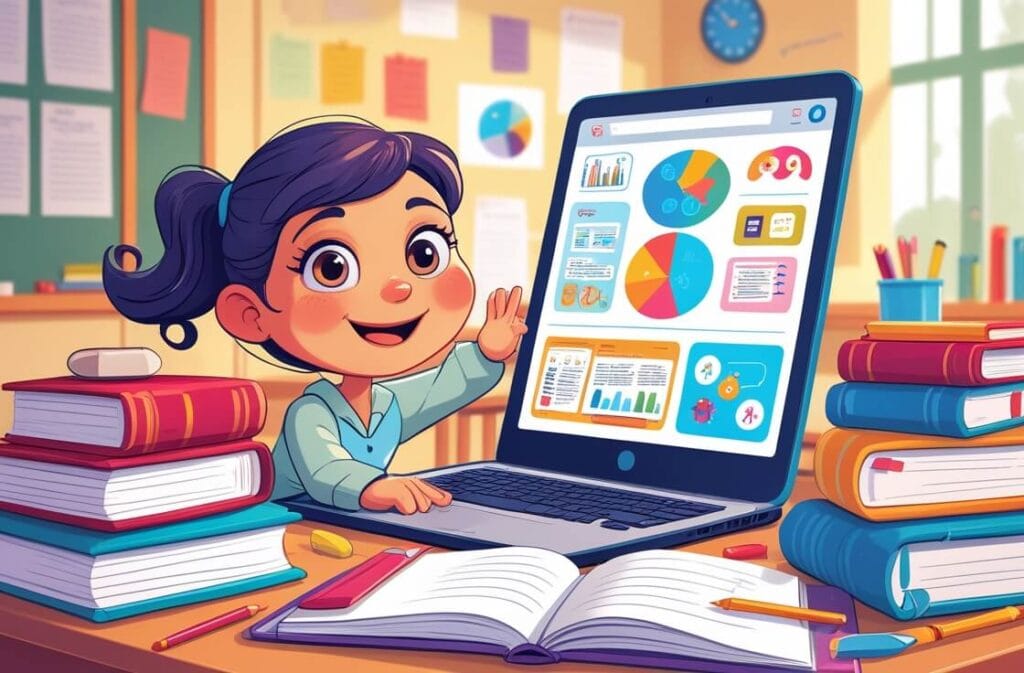
This is where I had to unlearn some bad habits. When I first discovered AI for learning, I got so excited that I basically abandoned all my traditional study techniques. I stopped taking handwritten notes, stopped using physical textbooks, and tried to do everything through AI. Big mistake! My retention actually got worse, not better.
The sweet spot for AI for learning isn’t replacing traditional methods – it’s enhancing them. The most effective approach I’ve found combines the strengths of AI learning with proven traditional study techniques. Together, they create a learning system that’s more powerful than either approach alone.
Traditional note-taking is a perfect example of how to integrate AI learning effectively. I still take notes by hand during lectures or while reading because the act of writing helps me process and remember information. But here’s where AI for learning comes in: after my study session, I’ll feed my notes into an AI learning tool and ask it to identify gaps, clarify confusing points, or provide additional context. The AI for learning becomes a way to deepen and reinforce what I learned through traditional methods.
Active recall is one of the most effective traditional learning techniques, and AI learning supercharges it. I use flashcard apps for spaced repetition, but I create the cards using AI for learning tools. I’ll ask the AI to generate questions based on material I’m studying, then I manually review and sometimes adjust them. The AI learning does the heavy lifting of creating review materials, while I do the cognitive work of actually recalling information.
Study groups are traditional but incredibly valuable, and AI for learning can enhance them in interesting ways. My study group now uses AI learning to settle debates about concepts, generate practice problems for group work, and even create hypothetical scenarios for us to discuss. We still meet face-to-face and have those important peer-to-peer explanations, but AI learning supplements our sessions with on-demand expertise and resources.
Here’s how I effectively integrate AI for learning with traditional study methods:
- Reading textbooks → Use AI learning to clarify confusing passages and provide additional examples
- Attending lectures → Follow up with AI for learning to explore topics mentioned but not fully explained
- Practice problems → Work problems traditionally first, then use AI for learning to understand mistakes
- Writing essays → Draft traditionally, use AI learning for research and feedback, but do final editing yourself
- Memorization → Use traditional mnemonic devices, verify and enhance them with AI for learning
- Concept mapping → Create maps by hand, use AI learning to identify missing connections
- Teaching others → Prepare using traditional methods and AI learning, deliver teaching traditionally
One integration approach that really works for me is the “sandwich method” with AI learning. I start with traditional study of a topic (reading, watching lectures, etc.), then use AI learning in the middle to deepen understanding and fill gaps, then return to traditional methods (practice problems, discussions) to consolidate learning. This sandwich structure uses AI learning strategically rather than letting it dominate my entire learning process.
Physical textbooks and other traditional resources still have value even in an AI learning world. I’ve found that the linear, structured presentation of information in textbooks provides a foundation that the more conversational, adaptive nature of AI for learning can build upon. I’ll read a chapter in my textbook to get the systematic overview, then have interactive conversations with AI for learning tools to explore aspects that interest me or confuse me.
The Feynman Technique – explaining concepts in simple terms to test your understanding – combines beautifully with AI for learning. I’ll use traditional methods to learn something, then explain it in my own words to an AI learning tool and ask for feedback on my explanation. The AI can point out misconceptions or gaps that I might not catch explaining to a human friend who’s equally unfamiliar with the material.
Handwritten notes have a special place in my integrated approach to AI for learning. Research shows that writing by hand activates different neural pathways than typing, leading to better retention. So I take handwritten notes during my initial learning, then I might use AI learning tools to expand on those notes, create study guides, or generate quiz questions based on them. The handwriting happens first, the AI for learning augmentation comes second.
One mistake people make with AI learning integration is using it as a crutch to avoid the hard work of actual learning. I’ve seen people (and did this myself initially) just ask AI learning tools to summarize everything rather than reading the original material. That’s not integration – that’s replacement, and it’s not effective. Real integration means using AI learning to enhance your engagement with material, not to avoid engaging with it.
The role of AI for learning in exam preparation should be integrated carefully. I use traditional practice exams and past papers to test myself under realistic conditions – no AI assistance during the actual practice test. But after completing it, I use AI learning to understand every mistake, explore why I got questions wrong, and identify patterns in my errors. The AI for learning becomes my post-game analysis tool, helping me learn more from each practice session.
Physical study spaces and routines remain important even when heavily using AI learning. I maintain a consistent study location, specific times for learning, and traditional rituals (like making tea before studying) that signal to my brain it’s time to focus. The AI learning tools I use fit into these routines rather than disrupting them. Structure supports learning, even when that learning increasingly involves AI.
Group discussions and peer learning have a synergy with AI for learning that I didn’t initially appreciate. My study partners and I will sometimes pose questions to AI learning together, discuss the responses, debate their accuracy, and collectively decide what makes sense. This critical engagement with AI-generated content – rather than passive acceptance – makes us better learners. The AI learning provides material, but we provide the critical thinking.
Tracking Progress and Measuring Learning Outcomes

I used to be terrible at tracking my progress with AI for learning. I’d study for weeks or months and have no idea if I was actually improving or just spinning my wheels. The AI learning tools were providing information, I was engaging with them, but was I really LEARNING? Without measurement, I had no way to know.
Tracking progress with AI for learning is fundamentally different from traditional education, where grades and test scores provide clear metrics. With AI learning, you’re often self-directed, so you need to create your own accountability systems. The good news is that AI for learning tools can actually help you measure your progress if you set them up correctly.
The first tracking system I implemented was a simple learning journal. Every time I used AI for learning tools, I’d spend five minutes writing about what I studied, what clicked, what still confused me, and how I felt about my progress. This qualitative tracking turned out to be surprisingly valuable. I could look back and see patterns – certain topics consistently clicked faster than others, some AI learning approaches worked better for me than others, and I could track my growing confidence over time.
Quantitative metrics matter too with AI learning. I started tracking things like: how many study sessions per week I completed, how long each session lasted, how many concepts I covered, and how many practice problems I solved correctly. These numbers don’t tell the whole story, but they provide objective data points that complement my subjective journal entries. When I’m using AI for learning consistently (at least 5 sessions per week), my understanding demonstrably improves.
One powerful tracking method with AI learning is periodic self-testing. Every week or two, I ask an AI learning tool to quiz me on everything I’ve studied recently without giving me any hints or referring back to previous conversations. It’s like a fresh start – can I recall and apply what I learned? I track my scores on these self-tests, and watching that number climb over time is incredibly motivating. It’s concrete evidence that AI for learning is actually working.
Here are the key metrics I track with AI for learning:
- Consistency metrics – Study sessions per week, average session length, longest streak of daily study
- Comprehension indicators – Self-test scores, ability to explain concepts without AI assistance, success rate on practice problems
- Depth of understanding – Can you apply concepts to new situations? Generate your own examples? Teach others?
- Speed of learning – How long does it take to grasp new concepts compared to when you started?
- Retention measures – Can you recall information from weeks or months ago?
- Application success – Can you use what you learned in real-world scenarios or projects?
The challenge with AI for learning progress tracking is avoiding vanity metrics. I made the mistake of measuring things like “number of AI conversations” or “total time spent with AI learning tools” – but those metrics don’t actually indicate learning. What matters is not how much you interact with AI for learning, but whether that interaction translates into knowledge and skills you can demonstrate independently.
I’ve found that project-based tracking works exceptionally well with AI for learning. Instead of just measuring how much I’ve studied, I set concrete projects or challenges that require applying what I’ve learned. For example, when learning Python programming with AI for learning tools, I committed to building a working application every two weeks. The complexity and functionality of those applications became a tangible measure of my progress.
AI for learning tools can help you track your progress if you ask them explicitly. I regularly ask AI assistants to review what we’ve covered in previous conversations and assess my growth. I’ll say something like “Based on our conversations over the past month, where have you seen my understanding improve, and where do I still have gaps?” This meta-analysis from AI learning provides perspective I might miss on my own.
Creating a personal curriculum roadmap enhanced my AI learning tracking significantly. I mapped out what I wanted to learn, broke it into milestones, and checked off achievements as I reached them. This visual representation of progress – seeing sections move from “not started” to “in progress” to “mastered” – kept me motivated and gave me a sense of direction. AI learning tools helped me define realistic milestones based on the typical learning curve for each topic.
One tracking technique that surprised me with its effectiveness was the “explain it to a friend” test. Periodically, I’d try to explain what I learned through AI for learning to someone with no background in the topic. If I could make it understandable to them without relying on jargon or looking things up, I counted that as genuine mastery. This human validation complemented the AI for learning tools nicely.
The retrospective review process has become essential in my AI learning journey. Every month, I dedicate an hour to reviewing my progress. I look at my learning journal, check my metrics, review difficult concepts I struggled with previously, and assess whether I’ve actually retained what I thought I learned. Often, I’ll discover that concepts I thought I understood have gotten fuzzy, and I need to use AI learning tools to refresh them. This periodic review catches knowledge decay before it becomes a serious problem.
Comparative benchmarking helped me understand if my AI for learning progress was on track. I’d find standard curricula or learning paths for topics I was studying and compare my timeline and outcomes. If a typical course covers certain material in 12 weeks, how am I doing with AI for learning? Sometimes I’m faster, sometimes slower, but having that reference point helps me calibrate expectations and adjust my approach when needed.
Progress tracking with AI for learning isn’t just about measuring success – it’s also about identifying patterns in failure. When I tracked which concepts consistently gave me trouble across multiple AI for learning sessions, I could dig deeper into why. Sometimes it revealed gaps in prerequisite knowledge. Other times it showed that certain explanations or approaches just don’t work for my brain, and I needed to try different strategies with AI for learning.
The emotional dimension of progress matters too, something traditional metrics often miss. I started rating my confidence level with each topic on a scale of 1-10 in my learning journal. Interestingly, my confidence didn’t always correlate perfectly with my actual performance on tests. Sometimes I felt more confident than my knowledge warranted, and sometimes I underestimated my understanding. Tracking both helped me calibrate my self-assessment over time, making me more accurate at judging what I actually know versus what I think I know when using AI learning.
Avoiding Common Pitfalls and Mistakes

Let me tell you about the mistakes I made with AI for learning – and boy, did I make some doozies! The biggest one? Trusting everything the AI told me without verification. I was learning about historical events once, and the AI for learning tool gave me a date that was off by a decade. I confidently used that information in a discussion, got corrected, and felt pretty foolish. That was my wake-up call about the limitations of AI for learning.
The first major pitfall with AI learning is over-reliance. It’s so easy to let the AI do all the thinking for you. I fell into this trap hard when I started using AI for learning for math problems. I’d ask for solutions and just read through them, nodding along, thinking I understood. Then I’d try problems on my own and realize I had no idea what to do! I was learning to recognize solutions, not to solve problems. That’s a crucial distinction with AI learning.
Passive consumption is another trap with AI for learning. You can have the most amazing AI tutor in the world, but if you’re just reading its responses without engaging your brain, you’re not really learning. I noticed this when I started tracking my retention – concepts I just read about in AI learning conversations disappeared from my memory within days. Concepts I actively wrestled with, asked follow-up questions about, and tried to apply stuck around for months. Active engagement is non-negotiable for effective AI for learning.
Here are the common mistakes to avoid with AI for learning:
- Accepting information without verification – Always cross-check important facts from AI for learning with authoritative sources
- Skipping the struggle – Don’t ask for answers immediately; try problems yourself first
- Ignoring fundamentals – Don’t jump to advanced topics before mastering basics, even if AI for learning makes it seem easy
- Not practicing retrieval – Reading explanations isn’t enough; you need to actively recall information
- Overlooking context limitations – AI for learning tools have knowledge cutoffs and can miss recent developments
- Avoiding human interaction – AI learning shouldn’t replace discussions with teachers, mentors, and peers
- Treating all responses equally – Learn to recognize when AI learning is confident vs. uncertain
The hallucination problem with AI for learning is real, and I learned this the hard way. AI systems sometimes generate convincing-sounding information that’s partially or completely false. It happened to me with a technical concept – the explanation sounded perfect, used proper terminology, seemed logical. Only when I tried to apply it in a real project did I discover it was nonsense. Now I verify anything critical from AI for learning against established resources or expert humans.
Depth versus breadth is a balance I struggled with using AI learning. The tools make it so easy to jump from topic to topic, getting surface-level explanations of dozens of concepts. I’d feel productive, like I was learning so much, but I wasn’t developing deep understanding of anything. I had to consciously force myself to slow down with AI for learning, spend multiple sessions on single concepts, and resist the temptation to constantly explore new topics before mastering current ones.
Another mistake I made was not customizing the difficulty level appropriately with AI learning. Early on, I’d sometimes ask for expert-level explanations when I needed beginner material, or vice versa. This either left me completely confused or insufficiently challenged. Learning to accurately assess my current level and request appropriate difficulty from AI learning tools took time but made a huge difference in my progress.
The copy-paste trap is particularly dangerous with AI for learning, especially for students. I’ve seen people (and almost did this myself) just copy AI-generated answers for homework or assignments. Beyond the obvious academic integrity issues, this completely defeats the purpose of AI learning. You’re not learning anything by copying – you’re just outsourcing your education to a machine. AI for learning should help you understand so YOU can produce quality work, not produce the work for you.
Time management becomes tricky with AI learning because the conversations can go on forever. I’ve lost hours going down fascinating rabbit holes with AI learning tools, learning interesting stuff but completely off-topic from what I actually needed to study. Now I set timers and specific objectives for each AI learning session. It’s okay to explore tangents occasionally, but not at the expense of your primary learning goals.
Neglecting to organize and review AI learning conversations was a huge mistake for me initially. I’d have great discussions, learn valuable things, and then never look at those conversations again. All that knowledge just evaporated. Now I treat AI for learning conversations as study materials that need to be reviewed, summarized, and integrated into my broader notes and understanding.
The social isolation risk with AI for learning is something I didn’t anticipate. I got so comfortable learning alone with AI that I started avoiding study groups and class discussions. Big mistake! Human interaction brings perspectives and understanding that AI for learning can’t replicate. Other people ask questions you wouldn’t think of, explain things in ways that might click better, and provide motivation and accountability. AI for learning should supplement human learning communities, not replace them.
One subtle pitfall is developing a dependence on AI learning that undermines your confidence. I noticed this when I started feeling anxious about learning anything without AI assistance. What if I needed to understand something and didn’t have access to my AI for learning tools? That dependency isn’t healthy. I had to consciously practice learning through traditional methods too, maintaining diverse learning capabilities.
The personalization paradox with AI for learning is interesting – the tools can adapt so perfectly to your preferences that you never get pushed out of your comfort zone. If you always ask for visual explanations because that’s your strength, you never develop your ability to learn from text or audio. I had to intentionally use AI learning to practice with my non-preferred learning styles, building more flexible learning capabilities rather than just reinforcing my existing preferences.
Advanced Strategies for Maximizing AI Learning
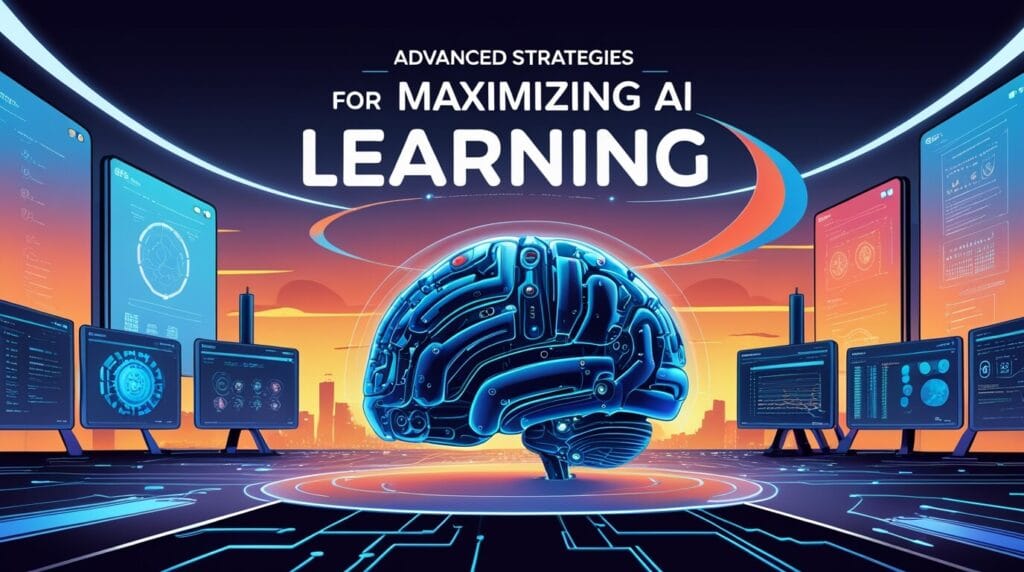
Once I got comfortable with the basics of AI for learning, I started discovering advanced strategies that took my results to another level. These aren’t things you’d figure out in your first month – they came from months of experimentation, mistakes, and occasional breakthroughs. But implementing these advanced approaches transformed AI for learning from a useful tool into an genuinely powerful educational system.
The Socratic method with AI for learning is probably my favorite advanced technique. Instead of asking the AI to explain things, I ask it to guide me to discover the answer myself through questions. I’ll say “I’m trying to understand [concept]. Don’t tell me the answer – ask me guiding questions that will help me figure it out.” This turns AI learning into a coach rather than a lecturer. The understanding that comes from self-discovery sticks so much better than passively receiving information.
Creating synthetic learning challenges with AI for learning has been incredibly effective for skill development. I ask the AI to generate increasingly difficult scenarios or problems that I wouldn’t find in textbooks. For example, when learning programming, I’d say “Create a unique coding challenge that combines concepts X, Y, and Z in an unexpected way.” These custom challenges from AI for learning fill gaps that standard educational materials miss and prepare me for real-world application better than typical practice problems.
Multi-model learning is an advanced AI learning strategy where I use multiple different AI systems for the same topic. Different AI models have different strengths and sometimes explain things differently. When I’m struggling with a concept, I’ll work through it with two or three different AI learning tools and compare their explanations. The overlapping information gives me the core truth, while the differences expose me to multiple perspectives that deepen understanding.
Here are advanced AI for learning strategies that dramatically improved my results:
- Deliberate mistake-making – Ask AI for learning to explain why incorrect approaches are wrong, strengthening your understanding
- Reverse engineering – Give AI learning a solution and ask it to help you understand the problem-solving process
- Analogical reasoning practice – Ask AI to help you create your own analogies for concepts, not just provide pre-made ones
- Meta-cognitive reflection – Use AI learning to analyze your own thinking process and identify cognitive biases or gaps
- Interleaved practice – Mix topics within AI learning sessions rather than blocking by subject
- Spaced elaboration – Return to topics periodically with AI for learning, adding layers of understanding each time
The debugging approach to AI for learning changed how I handle confusion. When I don’t understand something, I now treat it like debugging code. I explicitly tell the AI for learning tool “I’m confused about this specific part” and work through my misunderstanding systematically. Sometimes I’ll even intentionally explain a concept wrong to the AI and ask it to identify my errors. This exposes the exact points where my thinking diverges from correct understanding.
Simulation and scenario-building with AI learning works brilliantly for subjects that involve decision-making or application. I’ll create hypothetical scenarios – “Imagine I’m a project manager facing this situation, what concepts from organizational behavior should I consider?” – and use AI learning to work through them. This bridges the gap between theoretical knowledge and practical application better than any textbook exercise.
The collaborative expert approach is an advanced AI for learning technique where I position the AI as a research partner rather than a teacher. I’ll propose theories, interpretations, or approaches and ask the AI to critique them like a colleague would. “Here’s my understanding of this phenomenon – what would an expert in this field say are the strengths and weaknesses of this interpretation?” This positions me as an active knowledge creator rather than a passive recipient, which accelerates learning significantly.
Creating custom learning frameworks with AI learning has been transformative. Instead of following the AI’s structure, I develop my own organizational framework for a subject, then use AI for learning to populate it with details and examples. This puts me in the driver’s seat intellectually. I’m deciding what’s important to understand and how topics relate, while AI for learning provides the content to fill out my framework.
The teach-back loop is an advanced AI learning strategy where I regularly switch roles with the AI. After learning something, I’ll say “Now I’m going to teach this back to you. Pretend you’re a student, and point out anything I explain incorrectly or unclearly.” Teaching forces you to organize knowledge coherently, and having AI for learning critique your teaching exposes gaps that you’d miss in your own self-assessment.
Cross-domain transfer practice with AI for learning helps build deeper, more flexible understanding. I’ll learn a concept in one field, then ask AI for learning “How would this principle apply in a completely different domain?” For example, learning about feedback loops in engineering and asking how they apply to psychology or economics. This cross-pollination creates richer mental models than staying within a single domain.
The historical evolution approach to AI learning is something I stumbled on accidentally but now use deliberately. Instead of just learning current understanding, I ask AI for learning “How did our understanding of this evolve over time? What were the misconceptions, and what evidence changed our thinking?” Understanding the journey to current knowledge often makes the knowledge itself more comprehensible and memorable.
Constraint-based learning challenges with AI learning push your understanding in interesting ways. I’ll ask the AI to help me explain concepts with specific constraints – “Explain quantum entanglement using only single-syllable words” or “Describe the French Revolution without using any proper names.” These artificial limitations force deeper processing and creative thinking that enhances learning.
Ethical Considerations and Responsible AI Use
I’ll be honest – I didn’t think much about ethics when I started using AI for learning. I just wanted to learn stuff more effectively! But as I got deeper into AI for learning, I realized there are genuine ethical considerations that responsible learners need to think about. Ignoring them can lead to problems both for you and for the broader educational community.
Academic integrity is the big one with AI learning. The line between using AI to learn and using AI to cheat can get blurry. I had to develop a clear personal code: AI for learning is for understanding concepts and getting feedback on my OWN work, not for generating work to pass off as my own. When I write an essay, I might use AI learning to clarify research questions or check if my arguments make sense, but I write every word myself. That’s the difference between learning and cheating.
The dependency question with AI for learning is ethically significant too. Are we developing our own capabilities, or are we outsourcing our thinking to machines? I wrestle with this regularly. My rule of thumb: if I couldn’t explain or do something without AI assistance, I haven’t actually learned it yet. AI learning should make me more capable independently, not less. It’s a tool for building my brain, not a crutch that keeps it weak.
Data privacy deserves serious consideration with AI for learning. Every conversation you have with these tools potentially feeds into datasets or gets stored somewhere. I’m careful about what personal information I share during AI learning sessions. I don’t include identifying details about myself, my school, or others in my prompts. I also read privacy policies (I know, boring!) before committing to AI for learning platforms, especially paid ones.
Here are key ethical principles for responsible AI for learning:
- Transparency – Be honest with teachers, employers, and institutions about how you use AI for learning
- Attribution – When AI for learning helps with work products, acknowledge it appropriately for the context
- Independence – Maintain the ability to think and learn without AI assistance
- Privacy consciousness – Protect your own data and others’ information in AI for learning interactions
- Equity awareness – Recognize that not everyone has equal access to AI for learning tools
- Critical thinking – Don’t blindly trust AI for learning; verify important information
- Respect for rules – Follow institutional policies about AI use, even if you disagree with them
The bias issue in AI for learning is something I’ve become more attuned to over time. AI systems can reflect and amplify societal biases present in their training data. I’ve noticed this occasionally in AI for learning – certain cultural perspectives being presented as universal truths, or some historical narratives being oversimplified. Being aware of this doesn’t mean avoiding AI for learning; it means engaging with it critically and seeking diverse sources to complement it.
Environmental impact is an ethical consideration with AI learning that people often overlook. AI systems consume significant computational resources and energy. Every query you send requires server processing somewhere. This doesn’t mean you shouldn’t use AI for learning, but it’s worth being intentional about your usage rather than mindlessly generating responses you don’t actually need or read. Make your AI for learning sessions count.
The impact on educators is an ethical dimension I hadn’t considered initially. As AI learning becomes more prevalent, how does it affect teachers, tutors, and educational institutions? I’ve tried to use AI learning in ways that complement rather than replace human educators. When I have access to teachers, I engage with them meaningfully. I use AI for learning for the additional practice and exploration that teachers don’t have time for in formal education settings.
Accessibility and equity in AI learning are crucial ethical concerns. I have easy access to powerful AI learning tools, but not everyone does. Some people lack reliable internet, devices, or the literacy to use these tools effectively. Being aware of my privilege in having access to AI for learning helps me appreciate it more and use it responsibly. It also motivates me to share knowledge and strategies with others when I can.
The question of what skills are worth developing in an AI learning age is fundamentally ethical. Should we still learn things that AI can do instantly? I think yes, but selectively. Basic numeracy, writing, and reasoning remain essential even with AI for learning. But memorizing every historical date or calculation method? Maybe not. The ethical learner uses AI learning to enhance fundamental human capabilities, not to skip developing them altogether.
Content moderation and safety with AI learning deserve attention too. These systems can sometimes provide harmful information if prompted inappropriately. Responsible use means not trying to manipulate AI for learning tools into generating dangerous content and reporting problems when you encounter them. We have some responsibility as users to help keep these systems safe for everyone.
The broader societal implications of widespread AI for learning adoption are worth considering. Are we moving toward a world where everyone has access to personalized education, or are we creating new forms of inequality? How does AI for learning change the value of credentials and formal education? These big questions don’t have simple answers, but thinking about them makes me a more thoughtful user of AI for learning.
Future responsibility with AI for learning is something I think about too. The habits and norms we establish now will shape how AI for learning evolves. By using these tools ethically and advocating for responsible development, we contribute to better AI for learning systems in the future. It’s not just about optimizing our individual learning – it’s about participating in shaping educational technology responsibly.
Future Trends and Emerging Developments
The AI for learning landscape is evolving so rapidly that what I write today might be outdated in months! But there are clear trends emerging that I’m watching closely because they’re going to fundamentally transform how we use AI for learning in 2026 and beyond. Some of this stuff is already here in early forms, and some is on the horizon.
Multimodal AI learning is one of the most exciting developments. We’re moving beyond text-only interactions to AI systems that can process and generate images, audio, video, and even interactive simulations. I’ve started experimenting with AI for learning tools that can analyze diagrams I draw, watch me solve problems on video, or generate custom visualizations to explain concepts. This multimedia approach to AI for learning is so much more powerful than text alone, especially for visual or hands-on learners like me.
Personalized learning companions represent the next evolution in AI learning. Instead of separate tools for different subjects, we’re getting AI assistants that know your entire learning history, understand your cognitive patterns, and can help across all domains. Imagine an AI for learning companion that remembers you struggled with fractions in elementary school and connects that to difficulties with probability you’re having now in college. That long-term, holistic understanding is becoming possible.
Real-time feedback systems are advancing rapidly in AI for learning. I’m seeing tools that can watch you work through problems and provide immediate guidance – not just at the end, but during the problem-solving process. For coding, this means AI for learning that suggests approaches as you write. For writing, it means instant feedback on argument structure and clarity. This real-time AI for learning support is like having a tutor looking over your shoulder constantly.
Here are the emerging trends in AI learning to watch:
- Emotional intelligence – AI systems that recognize frustration, confusion, or disengagement and adapt accordingly
- Collaborative learning AI – Tools designed for group learning that facilitate discussions and coordinate study activities
- Assessment revolution – Moving beyond multiple choice to AI learning that evaluates understanding through conversation and application
- Integration with physical tools – AR/VR combined with AI for learning for immersive educational experiences
- Specialized domain models – AI for learning systems trained specifically for medicine, law, engineering, etc.
- Blockchain credentials – Verifiable records of learning achievements through AI for learning platforms
The shift toward AI for learning that teaches learning itself is fascinating. Future systems won’t just help you learn specific content – they’ll help you become a better learner overall. They’ll identify your metacognitive strengths and weaknesses, suggest learning strategies tailored to your brain, and help you develop more effective study habits. This meta-learning focus in AI for learning could be more valuable than any specific content knowledge.
Adaptive difficulty systems in AI learning are getting incredibly sophisticated. We’re moving beyond simple “easy/medium/hard” to AI that adjusts challenge levels continuously based on your current state. Feeling sharp and confident? The AI learning cranks up the difficulty. Having an off day? It provides more support without making you feel infantilized. This dynamic adaptation makes learning more efficient and less frustrating.
The integration of AI for learning with formal education is accelerating. More schools and universities are incorporating AI learning tools into official curricula rather than treating them as external supplements. This creates interesting opportunities for blended learning where AI for learning handles personalized practice and exploration while human teachers focus on discussion, mentorship, and higher-order thinking.
Specialized AI learning for different age groups and developmental stages is emerging. The AI for learning tools appropriate for elementary students are very different from those for college students or adult professionals. We’re seeing more age-appropriate AI learning systems that understand developmental psychology and adjust their approach accordingly. This specialization makes AI for learning more effective across the lifespan.
The democratization of advanced AI for learning is a trend I’m particularly excited about. Tools that were only available to elite institutions or wealthy individuals are becoming accessible to everyone. Open-source AI for learning projects are proliferating. This accessibility could help level the playing field in education globally, though equity challenges remain around internet access and digital literacy.
Voice-first AI for learning is growing, especially for language learning and accessibility. Having conversations with AI learning systems using voice feels more natural than typing for many people. It’s particularly powerful for pronunciation practice, oral exam preparation, and learning while commuting or exercising. I’ve started doing more voice-based AI for learning sessions during walks, which combines physical activity with mental exercise beautifully.
The role of AI for learning in workplace training and professional development is expanding dramatically. Companies are using AI learning systems for employee onboarding, skill development, and continuous learning. The ability to provide personalized, just-in-time training through AI learning is more efficient than traditional corporate training programs. This workplace adoption is driving investment and innovation in AI for learning.
Ethical frameworks and governance around AI learning are being developed as the technology matures. We’re seeing more attention to issues like bias in AI learning systems, data privacy protections, and guidelines for appropriate use in educational settings. This increased focus on responsible AI for learning is important for ensuring the technology benefits everyone fairly.
AI for Learning

Looking back on my journey with AI for learning, I’m amazed at how much it’s transformed my approach to education. What started as curiosity about a new technology became a fundamental shift in how I acquire knowledge and develop skills. The learning curve had its frustrations – the mistakes I made, the hours I wasted on ineffective approaches – but those struggles taught me as much as the successes did.
The most important lesson I’ve learned about AI learning is that it’s not magic. It won’t automatically make you smarter or more knowledgeable. What AI for learning does is amplify your effort and make your learning process more efficient, personalized, and engaging. But you still have to do the work – the thinking, the practicing, the struggling with difficult concepts. AI for learning is a powerful tool, but you’re still the one building your understanding.
What really excites me about the future of AI for learning is the potential for educational equity. These tools could give everyone access to personalized tutoring and vast educational resources that were previously available only to privileged few. A kid in a rural area with limited educational resources could access world-class AI learning tools on a smartphone. An adult changing careers could reskill affordably using AI for learning. The barriers to education are coming down, and that’s genuinely revolutionary.
But I also think it’s crucial to approach AI for learning with eyes wide open about its limitations and challenges. These systems make mistakes. They can be biased. They lack the human judgment, empathy, and wisdom that great teachers provide. The ethical questions around AI learning – about academic integrity, about dependency, about equity – don’t have simple answers. We’re navigating new territory, and we need to be thoughtful about it.
My advice to anyone starting with AI for learning? Start small. Pick one or two tools and really learn to use them well before expanding your toolkit. Be patient with yourself as you figure out what works for your brain. Don’t abandon traditional learning methods – instead, figure out how AI learning can enhance them. Stay curious, stay critical, and stay engaged in your own learning process.
Remember that effective AI learning is highly personal. What works brilliantly for me might not work for you, and vice versa. Experiment with different approaches, track what produces results, and don’t be afraid to abandon strategies that aren’t serving you. The beauty of AI for learning is its flexibility – use that to your advantage by customizing your approach relentlessly.


